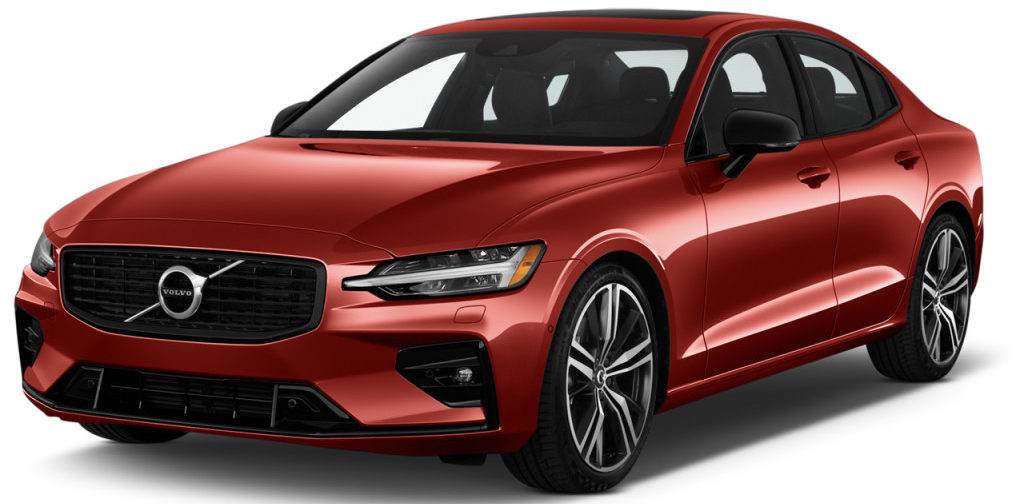- Position the load firmly against the rear seat’s backrest.
- Heavy objects should be placed as low as possible. Avoid placing heavy loads on lowered backrests.
- Cover sharp edges with something soft to avoid damaging the upholstery.
- Secure all loads to the load retaining eyelets with straps or web lashings.
- Always secure the load. During heavy braking the load may otherwise shift, causing injury to the car’s occupants.
- Cover sharp edges and sharp corners with something soft.
- Switch off the engine and apply the parking brake when loading/unloading long items. Otherwise, you may accidentally knock the gear lever or gear selector with the load into a drive position – and the car could then move off.
- To expand the cargo area and simplify loading, the rear seat’s backrest can be lowered. Note that objects must not prevent the function of the WHIPS system for the front seats if any of the rear seat’s backrests is folded down.
- A through-load hatch in the rear seat can be folded down for carrying long and narrow loads.
Bag hooks
Bag hooks keep carrier bags in place and prevent them from overturning and spreading their contents across the cargo area.
There is a bag hook in the side panel on each side of the cargo area.
Lower the hook from beneath the parcel shelf. Hang sufficiently deep bags with handles from the hooks.
Load retaining eyelets
- Hard, sharp and heavy objects that are loose or protrude may cause injury during heavy braking.
- Always secure large and heavy objects with a seatbelt or cargo retaining straps.
Roof load and loading on load carriers
For loading on the car’s roof, the load carriers that Volvo have developed are recommended.
This is to reduce the risk of damage to the car. Volvo’s load carriers are available for purchase at authorised Volvo retailers.
Carefully follow the installation instructions supplied with the carriers.
- Distribute the load evenly over the load carriers. Put the heaviest objects at the bottom.
- Check periodically that the load carriers and load are properly secured. Lash the load securely with retaining straps.
- If the load is longer than the car at the front, e.g. a canoe or kayak, fit the towing eye to its front socket and attach the bungee to this.
- The size of the area exposed to the wind, and therefore fuel consumption, increase with the size of the load.
- Drive gently. Avoid quick acceleration, heavy braking, and hard cornering.
- The car’s centre of gravity and driving characteristics are altered by roof loads.
- Follow the car’s specifications with regard to weights and maximum permitted load.
Towbar-mounted bicycle rack
When using a bicycle rack, the bicycle racks that Volvo has developed are recommended.
This is in order to avoid damage to the car and in order to achieve the maximum possible safety during a journey. Volvo’s bicycle racks are available for purchase at authorised Volvo dealers.
Carefully follow the instructions enclosed with the bicycle rack.
- The bicycle rack including load must weigh a maximum of 75 kg (165 pounds).
The bicycle rack can loosen from the towbar if it
- is incorrectly fitted on the towball
- is overloaded, see the bicycle rack’s instructions for maximum load weight
- is used for carrying something other than bicycles.
The car’s driving characteristics are affected when a bicycle rack is fitted on the towbar. For example due to:
- increased weight
- reduced acceleration capacity
- reduced ground clearance
- changed braking capacity.
Load according to the following recommendations:
- Fit the heaviest bicycle furthest in, closest to the car.
- Keep the load symmetrical and as close to the centre of the car as possible e.g. by loading the bicycles facing alternately if several bicycles are loaded.
- Remove loose objects from the bicycle for transportation, e.g. bicycle basket, battery, child seat. Partly to reduce the load on the towbar and bicycle rack, and partly to reduce the wind resistance, which affects fuel consumption.
- Do not use protective covers on the bicycles. This may affect maneuverability, impair visibility and increase fuel consumption. It may also lead to an increased load on the towbar.
Driving with a trailer
When driving with a trailer, there are a number of points that are important to think about regarding the towbar, the trailer and how the load is positioned in the trailer.
Payload depends on the car’s kerb weight. The total of weight of the passengers and all accessories, e.g. towbar, reduces the car’s payload by a corresponding weight.
The car is supplied with the necessary equipment for towing a trailer.
- The car’s towbar must be of an approved type.
- Distribute the load on the trailer so that the weight on the towbar complies with the specified maximum tow ball load. Towball load is calculated as part of the car’s payload.
- Increase the tyre pressure to the recommended pressure for a full load.
- The engine is loaded more heavily than usual when driving with a trailer.
- Do not tow a heavy trailer when the car is brand new. Wait until it has been driven at least 1000 km (620 miles).
- The brakes are loaded much more than usual on long and steep downhill slopes. Downshift to a lower gear when shifting manually and adjust your speed.
- Follow the regulations in force for the permitted speeds and weights.
- Maintain a low speed when driving with a trailer up long, steep ascents.
- The maximum indicated trailer weight only applies to heights up to 1000 metres above sea level (3280 ft). At higher elevations, the engine output and the vehicle’s climbing ability are reduced due to the reduced air density, and the maximum trailer load must therefore be reduced. The weight of the car and trailer must be decreased by 10% for each additional 1000 m (3280 ft) or part thereof.
- Avoid driving with a trailer on inclines of more than 12%.
Trailer weights
- Under certain circumstances, there may be a risk of overheating when towing a trailer. If the engine and drive system overheats, a warning symbol comes on in the driver display and a message is displayed.
- The automatic gearbox adapts the gears depending on load and engine speed.
- Depress the brake pedal.
- Activate the parking brake.
- Select gear position P.
- Release the brake pedal.
- Block the wheels with chocks when parking a car with a hitched trailer on a hill.
- Depress the brake pedal.
- Select gear position D.
- Releasing the parking brake.
- Release the brake pedal and start driving off.




